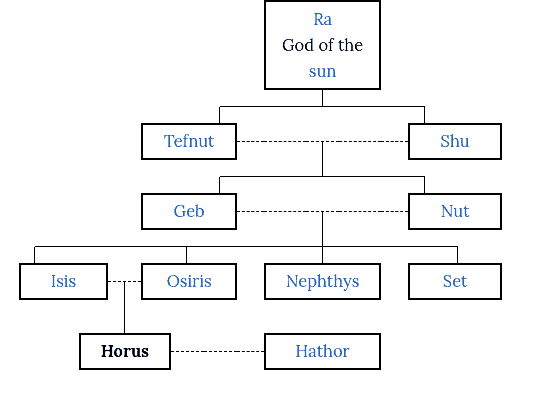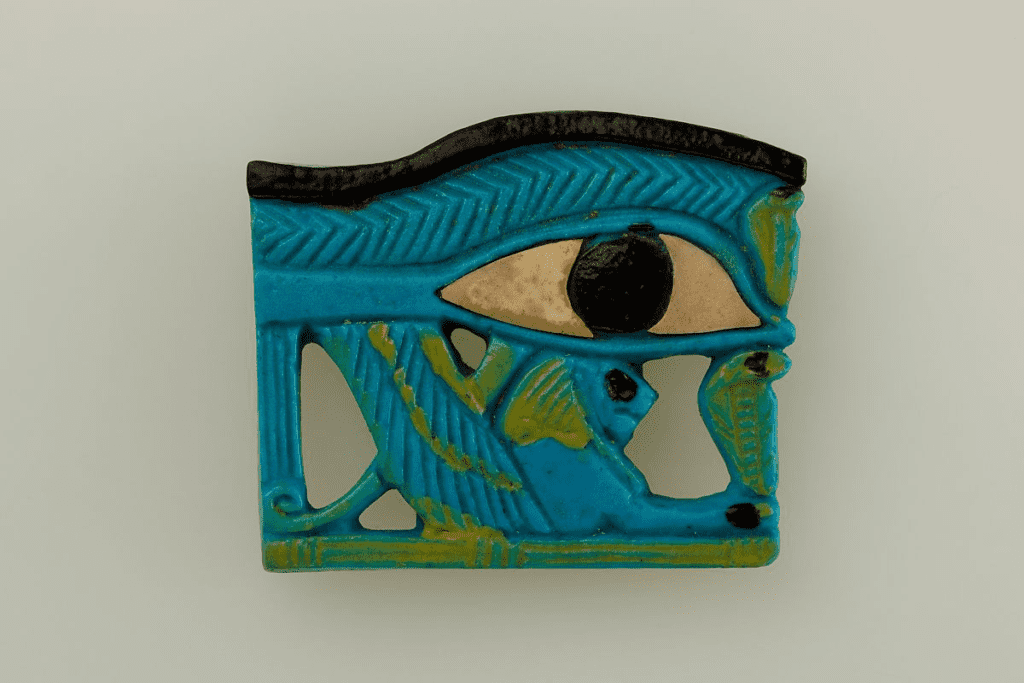In ancient Egypt, the eye of Horus symbolized protection, health, and healing. The eye is more a concept than an actual eye — a concept that carries deep symbolism to this day. Why is rejuvenation associated with something like an eye, and who was Horus? Well, it’s not your usual story, so buckle up.

Horus and weird penis stories
Horus is one of the most important gods in ancient Egyptian mythology. He was the god of several things, but most notably, he was the god of the sky. Egyptians would most often depict Horus as a falcon (a lanner falcon or peregrine falcon), or as a man with a falcon head. Hieroglyphs also record Horus as a falcon — but this particular god is not easy to understand.
Different forms of Horus are recorded in history, and some historians consider these to be different gods, or at the very least, different manifestations of the same god. This is consistent with how Ancient Egyptians viewed the multiple facets of reality. To make matters even weirder, the Egyptians believed that words and images could affect reality, so they avoided the risk of making negative events real. For Ancient Egyptians, myths played an integral part in their culture and life, but while myths are frequent in writings and art, they’re rarely presented in a complete fashion. So while Horus is one of the most important deities in Egypt, he takes on many forms and Egyptologists generally believe it’s impossible to distinguish the ‘one true’ Horus.
Still, when a Horus is mentioned, it’s usually either Horus the older, one of the oldest gods in Egypt, the “son of the truth”, or Horus the young, the child of Isis and Osiris. It’s this latter that has the eye of Horus.

Nothing about Horus the young is normal. His father, Osiris, was killed by the god Set — a brother to both Isis and Osiris. Set chopped Osiris to pieces and Isis, Osiris’ wife, buried all the pieces — except for the penis, which fell into a river and was eaten by a catfish. Historians differ in their interpretation of what happened to Osiris’ penis, but somehow, Isis got ahold of it and used it to conceive Horus.
So Horus was born, and he and Set hate each other; they’re natural enemies and they have all sorts of battles fighting over dominion over Egypt. But we’re not done with the weird fertility stories.

At some point, Set appears to want to sexually assault Horus (or in some other interpretations, tries to seduce him), but Horus places his hand between his legs, catches Set’s semen and throws it into a river. Wanting revenge, Horus (and Isis) spill Horus’ semen on lettuce in Set’s garden, which Set then unknowingly consumed, becoming pregnant. This somehow meant that Horus had won that battle.
But it wasn’t the last battle.
A rejuvenating eye
In another fight between the two, Set managed to injure Horus’ eye and take it out. Interpretations vary once again — whether it was one eye, both eyes, where they were injured or taken out, whether they were buried or saved. Interpretations even vary regarding who helped Horus. But most commonly, it’s interpreted Horus was helped by another ancient god — Thoth.

Thoth, which often shows up as a baboon is often depicted holding an ankh, the Egyptian symbol for life, and was trying to bring peace between Horus and Set. The eye was rejuvenated and was so powerful that it had its own rejuvenation power.
At some point, Horus defeats Set, becomes the ruler of Egypt, and offers the eye to his father Osiris, who is in the afterlife. This rejuvenating eye was powerful enough to sustain Osiris and ultimately, this ritual became the prototype for the Egyptian funerary custom, in which offerings are sent to help sustain a person in the afterlife.

But the symbol of the eye extends even further. The eye was rejuvenating, healing, it could ward off evil and even more — or so ancient Egyptians believed.
Through wordplay, the Eye of Horus could be equated with any ritual act, which possibly led to the growth of the myth. The Eye came to symbolize all sustenance given to the gods; since life is a force that was circulated by the gods through our world, it was a part of returning this force to them and maintaining the flow of life.
Thus, the Eye of Horus starts to become intertwined with the idea of maat, the Egyptian concept of cosmic order. Maat blends together concepts of order, harmony, morality, and justice — and the Eye of Horus binds it all together.
The eye itself, ambiguity, and symbolism
The eye became one of the most recognizable and powerful symbols in Ancient Egypt. In healing rituals, the patient was equated with Horus, so that the patient could be healed like Horus was. Amulets with the eye were produced as far back as 3,000 BC, and were prominent well into Roman times. For at least three thousand years, the amulet played an important role in Egyptian society. Archaeologists have found hundreds of amulets made from a variety of materials.

The eye itself is a stylized human eye with the facial markings of the falcon that signified Horus. Egyptians also rendered it as a hieroglyph (𓂀). The eye was made of six parts, which some researchers have interpreted as playing a role in mathematics — specifically, in fractions. In this interpretation, the inner corner of the eye stands for 1/2, the pupil for 1/4, the eyebrow for 1/8, the outer corner for 1/16, the curling line for 1/32, and the cheek mark for 1/64. However, this interpretation is challenged by other researchers.

Another indication regarding additional symbolism of the eye comes from Ptolemaic texts. Claudius Ptolemy was an astronomer and mathematician of the 2nd century AD, so about three thousand years after the eye of Horus started becoming a prominent symbol. Ptolemaic texts suggest that the sky was a falcon whose eyes represented the sun and the moon.
Plutarch, a Greek philosopher and historian that worked in the 1st and 2nd centuries AD also saw a connection to the moon. Plutarch suspected that the removal and rejuvenation is linked to the lunar phases and phenomena like eclipses.
Earlier pyramid texts, as old as 2500 BC, emphasize the eye’s instrumental role in ensuring a king’s safe passage to the afterlife, and his sustenance once he reaches the afterlife. Much like Horus used the eye to support his father Osiris in the afterlife, so too did Egyptians believe that they could support their king. The eye played a supreme role in ritual spells, particularly in offering spells. The religious symbolism is clear: the eye was essential for a safe passage to the underworld.
Of course, when talking about something that originated 5,000 years ago (and possibly, way before that), there’s bound to be some ambiguity and uncertainty. A particularly confusing aspect is the Eye of Ra.
The Eye of Ra is somewhat similar to the Eye of Horus. It belongs to a different god (Ra) but represents many of the same concepts — as well as some different ones. The Eye of Ra also has some independence from the god Ra, much like the Eye of Horus is partly independent from Horus. The Eye of Ra functions as a violent, feminine force that often behaves as an independent goddess. Egyptologist Katja Goebs suggests that the myths around the two eyes are based around the same mytheme, or core element of a myth. She suggests that “rather than postulating a single, original myth of one cosmic body, which was then merged with others, it might be more fruitful to think in terms of a (flexible) myth based on the structural relationship of an Object that is missing, or located far from its owner”.
Remember when we said concepts in Egyptian myth can be often a bit fluid or unclear? The same goes for the eyes. The roles of the two eyes sometimes overlap and the distinctions become unclear. Both could ward evil, both have a connection to Thoth, both were featured on amulets. The similarities are so great that sometimes, the two eyes were used interchangeably.

There’s also a sun-moon link to the eyes. The right eye of the god Horus, for instance, was equated with the sun, and his left eye equated with the moon. Ra was a prominent sun god, so at some point, his eye became associated with the sun, and Horus was “only” associated with the moon. But once again, Egyptologists have different interpretations. Some believe that initially, there were two Eyes of Horus that slowly diverged, with one of them becoming the Eye of Ra; others believe that since no text links the Eyes of Horus to the sun and moon until relatively late in Egyptian history, there must have been another original significance. Some have even proposed that the link between the Eye of Horus and the moon is represented mathematically.
The eye features six parts, each in geometric progression. Judging this in light of a cryptic notation found in some temples, a mathematical operation shows “that the fractions of the Eye signified a lunar period comparable to our notion of the mean synodic months,” one study reads. It could be a bit of a stretch, but it shows just how deep the ramifications of the Eye of Horus can be.
An eye that transcends time

The Eye of Horus is one of the most prevalent symbols in Egyptian mythology. It was prevalent for thousands of years and played a key role in rituals. The eye embodies healing power as well as regeneration and protection in general.
Its exact meaning and role are shrouded in the many years that have passed, and Egyptian myths are as fascinating as they are confusing. The symbol has a remarkable connection to many different concepts and may even be connected to mathematics, the human body, and the lunar cycle.
We may never fully understand the entire significance behind this symbol, but it remains one of the most striking and rich symbols of the ancient world. With additional research, we may yet learn its secrets.


